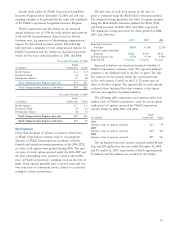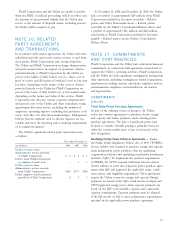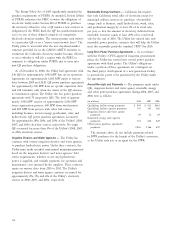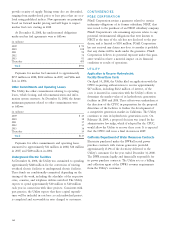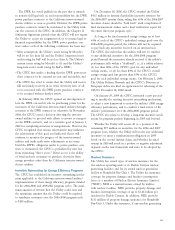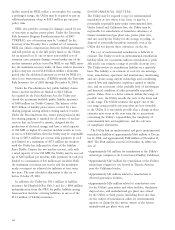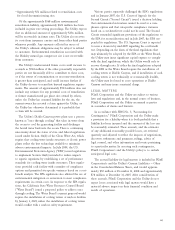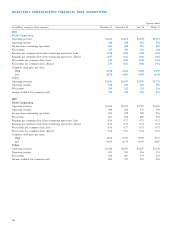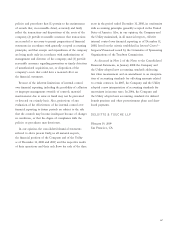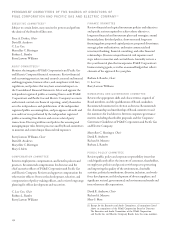PG&E 2008 Annual Report Download - page 145
Download and view the complete annual report
Please find page 145 of the 2008 PG&E annual report below. You can navigate through the pages in the report by either clicking on the pages listed below, or by using the keyword search tool below to find specific information within the annual report.143
Various parties separately challenged the EPA’s regulations
and in January 2007, the U.S. Court of Appeals for the
Second Circuit (“Second Circuit”) issued a decision holding
that environmental restoration cannot be used as a com-
pliance option and that site-specifi c compliance variances
based on a cost-benefi t test could not be used. The Second
Circuit remanded signifi cant provisions of the regulations to
the EPA for reconsideration and in July 2007, the EPA sus-
pended its regulations. The U.S. Supreme Court is expected
to issue a decision by mid-2009 regarding the cost-benefi t
test. Depending on the form of the fi nal regulations that
may ultimately be adopted by the EPA or the Water Board,
the Utility may incur signifi cant capital expense to comply
with the fi nal regulations, which the Utility would seek to
recover through rates. If either the fi nal regulations adopted
by the EPA or the Water Board require the installation of
cooling towers at Diablo Canyon, and if installation of such
cooling towers is not technically or economically feasible,
the Utility may be forced to cease operations at Diablo
Canyon and may incur a material charge.
LEGAL MATTERS
PG&E Corporation and the Utility are subject to various
laws and regulations and, in the normal course of business,
PG&E Corporation and the Utility are named as parties
in a number of claims and lawsuits.
In accordance with SFAS No. 5, “Accounting for
Contingencies,” PG&E Corporation and the Utility make
a provision for a liability when it is both probable that a
liability has been incurred and the amount of the loss can
be reasonably estimated. These accruals, and the estimates
of any additional reasonably possible losses, are reviewed
quarterly and adjusted to refl ect the impacts of negotiations,
discovery settlements and payments, rulings, advice of
legal counsel, and other information and events pertaining
to a particular matter. In assessing such contingencies,
PG&E Corporation’s and the Utility’s policy is to exclude
anticipated legal costs.
The accrued liability for legal matters is included in PG&E
Corporation’s and the Utility’s Current Liabilities — Other
in the Consolidated Balance Sheets, and totaled approxi-
mately $72 million at December 31, 2008 and approximately
$78 million at December 31, 2007. After consideration of
these accruals, PG&E Corporation and the Utility do not
expect losses associated with legal matters would have a
material adverse impact on their fi nancial condition and
results of operations.
• Approximately $51 million related to remediation costs
for fossil decommissioning sites.
Of the approximately $568 million environmental
remediation liability, approximately $123 million has been
included in prior rate setting proceedings. The Utility expects
that an additional amount of approximately $356 million
will be recoverable in future rates. The Utility also recovers
its costs from insurance carriers and from other third parties
whenever possible. Any amounts collected in excess of
the Utility’s ultimate obligations may be subject to refund
to customers. Environmental remediation associated with
the Hinkley natural gas compressor site is not recoverable
from customers.
The Utility’s undiscounted future costs could increase to
as much as $944 million if the other potentially responsible
parties are not fi nancially able to contribute to these costs,
or if the extent of contamination or necessary remediation
is greater than anticipated, and could increase further if
the Utility chooses to remediate beyond regulatory require-
ments. The amount of approximately $944 million does not
include any estimate for any potential costs of remediation
at former manufactured gas plant sites owned by others,
unless the Utility has assumed liability for the site, the
current owner has asserted a claim against the Utility, or
the Utility has otherwise determined it is probable that
a claim will be asserted.
The Utility’s Diablo Canyon power plant uses a process
known as “once through cooling” that takes in water from
the ocean to cool the generating facility and discharges
the heated water back into the ocean. There is continuing
uncertainty about the status of state and federal regulations
issued under Section 316(b) of the Clean Water Act, which
require that cooling water intake structures at electric power
plants refl ect the best technology available to minimize
adverse environmental impacts. In July 2004, the U.S.
Environmental Protection Agency (“EPA”) issued regulations
to implement Section 316(b) intended to reduce impacts
to aquatic organisms by establishing a set of performance
standards for cooling water intake structures. These regula-
tions provided each facility with a number of compliance
options and permitted site-specifi c variances based on a cost-
benefi t analysis. The EPA regulations also allowed the use of
environmental mitigation or restoration to meet compliance
requirements in certain cases. In response to the EPA regula-
tions, the California State Water Resources Control Board
(“Water Board”) issued a proposed policy to address once
through cooling. The Water Board’s current proposal would
require the installation of cooling towers at nuclear facilities
by January 1, 2021, unless the installation of cooling towers
would confl ict with a nuclear safety requirement.


